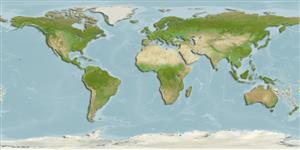>
Perciformes/Uranoscopoidei (Sand dwellers) >
Uranoscopidae (Stargazers)
Etymology: Xenocephalus: Greek, xenos = strange + Greek,kephale = head (Ref. 45335); australiensis: The name australiensis refers to the locality..
Environment: milieu / climate zone / depth range / distribution range
Ekologi
laut batidemersal; kisaran kedalaman 299 - 500 m (Ref. 42788). Subtropical
Southwestern Pacific: Known only from the continental slope of northwestern Australia.
Size / Weight / umur
Maturity: Lm ? range ? - ? cm
Max length : 30.0 cm TL jantan/; (Ref. 42788)
Minimum depth from Ref. 58018.
Life cycle and mating behavior
Maturities | Reproduksi, perkembang biakan | Spawnings | Egg(s) | Fecundities | Larva
Kishimoto, H., 2001. Uranoscopidae. Stargazers. p. 3519-3531. In K.E. Carpenter and V. Niem (eds.) FAO species identification guide for fishery purposes. The living marine resources of the Western Central Pacific. Vol. 6. Bony fishes part 4 (Labridae to Latimeriidae), estuarine crocodiles. FAO, Rome. (Ref. 42788)
Status IUCN Red List (Ref. 130435)
ancaman kepada manusia
Harmless
penggunaan manusia
Alat, peralatan
laporan khas
muat turun XML
Sumber internet
Estimates based on models
Preferred temperature (Ref.
123201): 7 - 7.1, mean 7 °C (based on 3 cells).
Phylogenetic diversity index (Ref.
82804): PD
50 = 0.5156 [Uniqueness, from 0.5 = low to 2.0 = high].
Bayesian length-weight: a=0.01000 (0.00244 - 0.04107), b=3.04 (2.81 - 3.27), in cm total length, based on all LWR estimates for this body shape (Ref.
93245).
Trophic level (Ref.
69278): 4.2 ±0.8 se; based on size and trophs of closest relatives
Daya lenting (Ref.
120179): sedang, Waktu penggandaan populasi minimum 1.4 - 4.4 tahun (Preliminary K or Fecundity.).
Fishing Vulnerability (Ref.
59153): Low vulnerability (20 of 100).
